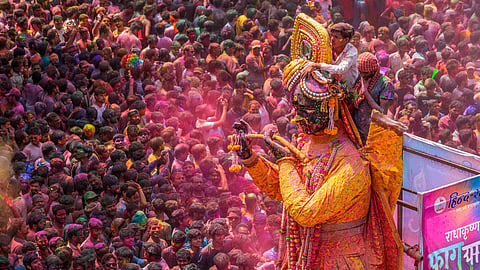From Yaosang to Dola Purnima, explore various types of Holi celebrations across India!
India and its cultural diversity never stops surprising and filling us all with sheer awe. The cuisine changes every few kilometres, and so does the folklore, an array of traditional practices and its versions of festivals.
Now that the festival of colours is almost here, let's talk Holi! Dive with us while we pick just a few places from across the country to explore how beautifully different their form of Holikotsav is! Here's to knowing who celebrates the festival with what - colours, mud, flowers or lathi?
Rang Panchami of the West
Madhya Pradesh, Maharashtra and Karnataka indulge in this version of Holi, called Rang Panchami. An extension of Holikotsav, the festival is also known as Shigmo in Maharashtra.
Celebrated across India on the 5th day of Holi (the day of Phalguna Krishna Paksha Panchami), the Rangpanchami Ger of Indore, that takes place annually at Rajwada, also holds a special place in the hearts of the local-ites. More than 5 lakh people gather, amidst loud music, to join in smearing colours and water on all those celebrating. Similarly, people of Karnataka collect at Hubballi's Kamaripeth to partake in a hueful Rangpanchami, worshipping idols of Kamanna and Rathi!
Phoolon Ki Holi of Vrindavan
One of the most wholesome ways of celebrating the festival of colours - Phoolon ki Holi in Vrindavan. Holi and Braj are synonymous to each other. Painted in deep historical and cultural narratives, the trio of Mathura, Vrindavan and Barsana form the Braj region, which is associated with the childhood home of Lord Krishna. The sacred cities, while they rest in ancient glory, annually throw a festival to remember! The 40-day extravaganza begins with Barsana’s Laddu Holi and Lathmar Holi.
Marked on the Ekadashi during the week of Holi, Vrindavan's Phoolon ki Holi, as the name goes, is played with petals of fresh flowers. Famously, the epicentre is Banke Bihari temple where throngs of Krishna disciples gather to celebrate. With soul-stirring fragrance and flowers filling the air to the brim, the panoramic view might be a 15-minute affair but never fails to leave its visitors entranced.
Yaosang of Manipur
The Manipuri form of Holi comes along with a joyous celebration of life. One of the most important festivals of Manipur, Yaosang is observed for five days in spring by the Meitei tribe. But, it's more than mere colours!
Yaosang kickstarts with worshippers chanting hymns and recitals, involves sports meets, with Holika Dahan equating to 'Yaoshang Mei Thaba' and hut burning and little kids collecting 'nakatheng' or lucky festive money. This is followed by the day of 'Pichkari' or playing with water and colours, more sports gathering and games (like that of 'Yubi Lakpi'), the Moonlight Folk Dance - its highlight - aka 'Thabal Chongba', the Brajamai Procession and the performance of Halankar!
Basant Utsav of West Bengal
Basanta Utsav, celebrated with love, light and life in West Bengal's Shantiniketan, welcomes Spring with a warm embrace. Students don yellow/white-coloured garments and greet their teachers with abeer and locals chant hymns in the University of Shantiniketan, which was founded by Rabindranath Tagore. This place is the cynosure of all Holi-related affairs and here echo the recitals of Tagore's poetry.
Participants lose themselves to the music, dance and sing to instruments like ektara, dubri and veena, among others. A tremendous procession of Krishna devotees (also called Dol Yatra) also make their presence known on the streets of Bengal.
Hola Mohalla of Punjab
The tradition of warrior Holi is also one not uncommon in India. From the grand royal Holi of Rajasthan to Hola Mohalla of Punjab, these glorious versions of the festival spark awe in the spectators.
Hola, a three-day long Sikh festival, either coincides with Holi or falls around it, depending on what the second day of Chett's lunar month is. Observed by the Nihang Sikhs dressed in blue, the festival revolves around a gallantry exhibit of martial arts and symbolises valour, brotherhood and fraternity. It is a mix of langars, music and poetry, kirtans and military-style processions to the beats of war drums!
Lathmar Holi of Uttar Pradesh
What could be a more unique way of celebrating Holikotsav than Lathmar Holi of Barsana and Nandgaon? Lathmar Holi, where, as per convention, women playfully beat men with sticks, seeks to recreate a Radha-Krishna tale. As per legend, Lord Krishna wanted to spray abeer on Radha and her friends but was playfully greeted by Radha with sticks.
It is commemorated in all glory in the twin towns of Barsana and Nandgaon, or the childhood homes of Radha and Krishna respectively. Huge crowds of people gather here every year to immerse in the festivities.
Similarly, Haryana's Dhulandi Holi involves the devar-bhabhi duo where the sisters-in-law pull pranks on the other party!
Dola Purnima of Odhisha
Marking the arrival of Spring, Odhisha celebrates its kind of Holi called 'Dolo Jatra' or Dola Purnima. Like the predominant roots of Holi go back to the legend of Radha and Krishna, Dola also is devoted to the two deities.
Beginning on Falgun Dashami, the festivities revolve around colours, Feni and Pethas, of course Thandai, Ghola Dahi, grand processions (or 'Dola Yatra'), Krishna idols being carried in hueful palanquins (or vimanas), showering of abeer and gulal, people playing games and engaging in playful activities and so much more! It is also observed in the states of West Bengal and Assam.
To get all the latest content, download our mobile application. Available for both iOS & Android devices.

